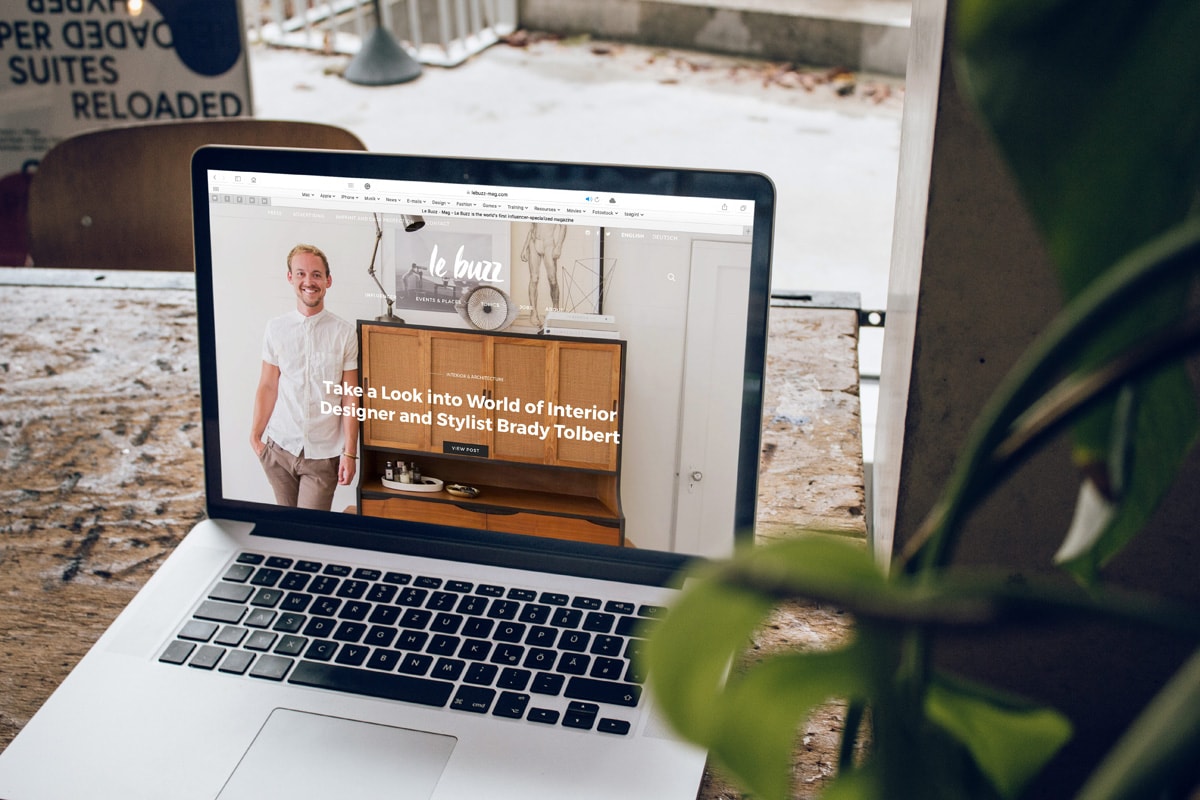How To Start A Blog And Make Money Online In 8 Steps
It’s our mission to make money matters a little less insane. We provide financial editorial content free for all and are supported by some of our affiliate partners included in this post which earns us a commission. We hope you enjoy our content and subscribe to our newsletter.
There have never been so many different ways to earn money online, and a blog is one of the most popular vehicles. With some basic knowledge, a few bucks, and a computer, anyone can get a blog up and running in no time.
Today, we’re going to show you exactly how to start a blog with Bluehost and begin making money in just eight steps. If you’re a first-time blogger or someone who has had some failed blogging attempts in the past, this guide is for you!
Why Should You Start a Blog?
The beauty of blogging is that you can start with little to no experience and still achieve incredible success. Whether you’re a high school student or the marketing director of a large business, there are a few different reasons why you might be interested in learning how to start a blog.
A. Share Your Voice
Do you have something to say but don’t have a platform? The decision to start a blog is a fantastic next step to making your unique voice heard.
By sharing your thoughts online, implementing SEO to increase visibility, and using social channels to bring more traffic to your blog, you’ll be able to grow an audience for your content.
B. Build Your Brand
Whether you’re a single person or a large corporation, a blog is an important branding piece for any business.
Not only does blogging help you grow an audience, but it also positions you as an authoritative and trustworthy voice within your particular industry or niche – a quality that is essential for earning conversions and sales. Research has shown that those with active blogs produce five times more conversions than those without blogs.
C. Earn Money
As the owner of a blog that sees significant organic traffic, you’re able to earn income through advertising, the selling of your products and services, and affiliate marketing opportunities.
While earning money doesn’t typically occur overnight, the bricks you lay when building your blog will have a significant influence on your ability to earn revenue from your blog down the road. People who stick to blogging over the journey are often able to replace and even exceed their full-time income.
If you have aspirations to share your thoughts and experiences with others, grow your brand, or earn money online, let’s help you get that blog off the ground!
How to Start a Blog in 8 Steps
While setting up a new blog is relatively easy, particularly if you have experience with blogs, it’s not a process you should try to tackle blindly. Attempting steps out of order can cost you unnecessary time and money, so learning how to start a blog beforehand will prevent plenty of headaches along the way.
1. Develop the Concept for Your Blog
If the desire to start your blog is there, it’s probable that you already have at least a rough idea for your blog; and if you’re blogging for your business, there’s an obvious niche or two right in front of you.
But if not, you’ll need to develop the concept for your blog before you do anything else. You’ll quickly find that it’s difficult to change the topic of your blog when you’re well into your blogging journey.
If you’re starting from square one, there are a few questions you should ask:
- What interests me most?
- What am I really good at?
- What am I most knowledgeable about?
Once you have answers to these questions, you should begin to forecast which of those concepts has the best chance of bringing you success.
First and foremost, you’re going to want to settle on a topic or niche that will have your full commitment. If you enjoy oil painting but don’t think that it will be able to hold your interest for the foreseeable future, you should turn your attention elsewhere.
Next, consider which of your shortlisted topics are most and least competitive. On one hand, a highly competitive niche – such as digital marketing, for example – has a higher ceiling for success and revenue than many other topics, because the topic has so many monthly readers.
But on the other hand, the topic is far more competitive than your average blog topic because other businesses also see the potential. Scaling your way to a top spot in search engines will prove difficult.
At the opposite end of the spectrum, you might be looking at a topic such as goat farming, or scrapbooking, or spelunking. These niches are far less competitive, and so their paths to the top are significantly easier. With fewer readers, however, your potential success is somewhat limited.
With all of these factors considered, narrow your blog options down to one that you believe will bring you some success.
2. Purchase Web Hosting
Next, it’s time to purchase web hosting.
What is web hosting?
In the simplest terms, web hosting allows you to go live with your website. Your web hosting service has secure servers where it stores the data of millions of websites and blogs. As a blog owner, you rent some of this space to give your blog a home and connect it to the internet.
To have a functioning website, the two elements you must have in place are web hosting and a domain name. It’s possible to get your domain name before your hosting, and people often do this. But you should research and purchase web hosting before you purchase a domain name, as a web hosting provider will often provide a free domain upon purchasing one of their packages.
So, where do you go for web hosting? There are dozens upon dozens of popular options for web hosting, but an outstanding web hosting service is Bluehost.
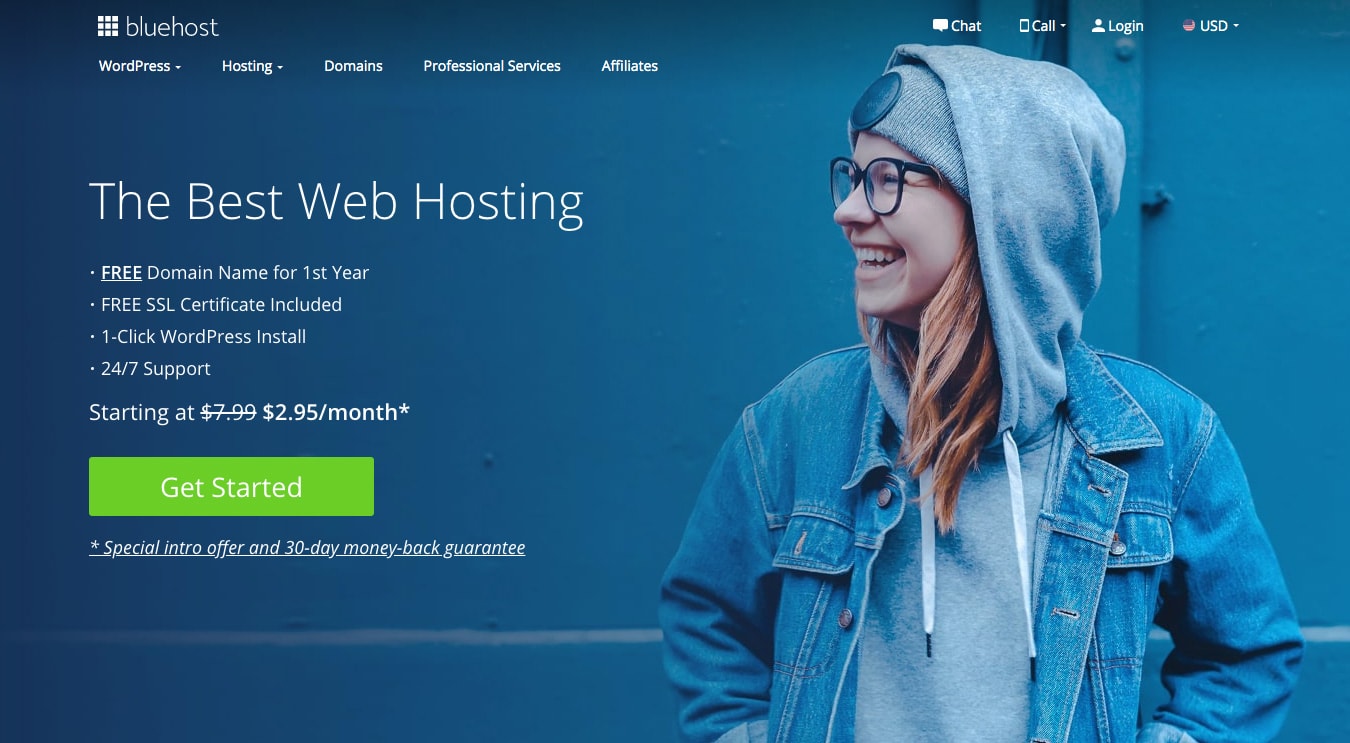
Bluehost
With more than 2 million sites hosted, Bluehost is a popular option among novice bloggers and experienced site builders alike. People love Bluehost because they offer 24/7 support, as well as an integrated experience with WordPress through their Bluerock platform. If, for any reason, you’re unhappy with the service, you’re able to get a full refund within 30 days.
Right now, you can get a basic package through Bluehost for just $3.95 per month. This package includes a free domain name for the first year, as well as a free SSL certificate – a must-have security feature for any person or business with aspirations of ranking within search engines or launching an online store.
Additionally, your package will include 50 GB of SSD storage, unmetered bandwidth, and access to top-notch customer support around the clock.
If you can spare a little more cash, you can upgrade to Bluehost’s Plus, Choice Plus, or Pro package, and receive hosting for an unlimited number of websites, unlimited domains, and unlimited SSD storage.
Click here to get your web hosting package with Bluehost today!
3. Choose Your Domain Name
Next up is your domain name.
Going through Bluehost, you’ll be prompted to choose a domain name (or use a domain name you already own) when creating your blog. Again, this domain name comes free when you get your web hosting with Bluehost, so take advantage of this offer and choose your Bluehost plan today.
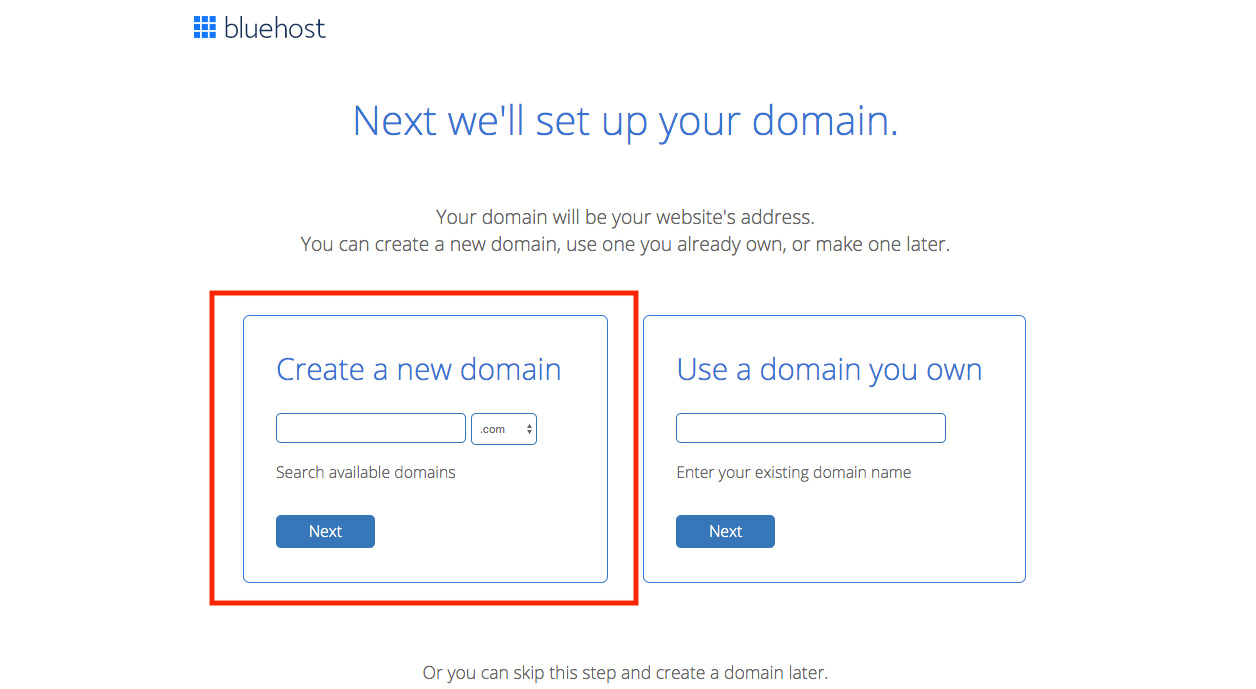
Bluehost
Now, there are two main parts of a domain name that you’ll have the ability to customize: the domain name itself and the top level domain (TLD). While you may not be familiar with these terms, you’ve seen them thousands of times online.
On our website, wallstreetinsanity.com, the domain name is “wallstreetinsanity” and the TLD is “.com”.

Bluehost
Assuming you’ve chosen a niche that you’re going to blog about, you should be able to brainstorm a few clever ideas for a domain name. Ideally, you’re going to want to settle on a name that is clever, memorable, and brief. You’ll also want to make sure it gives your audience some kind of indication of what your blog is about.
Keep in mind that your desired domain name might not always be available; so it’s wise to have a few ideas in your back pocket, in case your domain registrar lets you know that a particular domain name isn’t available.
However, if your best idea is unavailable and you don’t wish to shelve it, you can elect to change the top level domain instead.
In other words, if “newblogidea.com” is taken, you might settle for “newblogidea.org”, “newblogidea.net”, “newblogidea.co”, or even “newblog.idea”.
Once you have picked your domain name and Bluehost has confirmed its availability, you’ll be directed to the checkout screen to confirm your order. Place your order, and then finish setting up your account by creating a password to go along with your domain name.
With a great web hosting package in Bluehost and a catchy domain name in place, you’re now ready to tackle the fun part – designing and building out your new blog!
4. Choose Your CMS and Install a Theme
After logging into your Bluehost account for the first time, you’ll be prompted to name your blog and give it a tagline. You’ll also need to specify that you want your site to have a blog, and whether or not you also want it to include an online store. Keep in mind that you can always go back and make changes to these settings down the road.
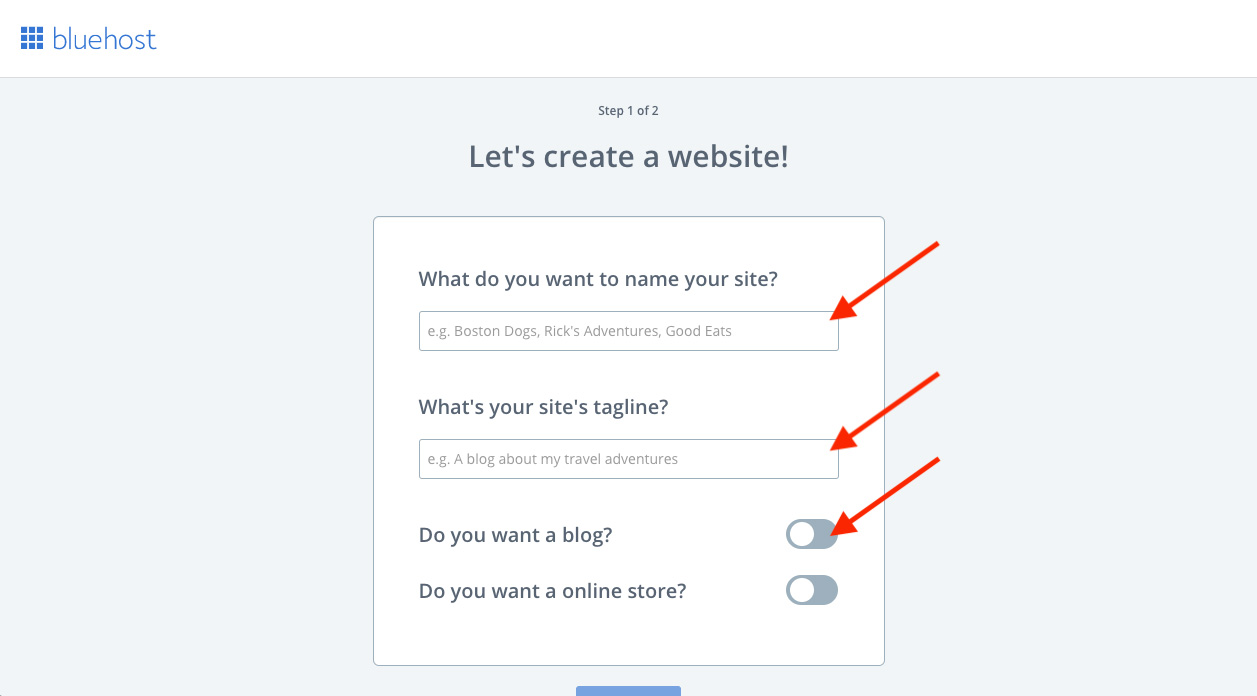
Bluehost
Next, you’ll be asked to share a little bit about the goals for your blog. Do you want your blog to be a creative outlet for your thoughts and ideas? Do you want to educate your target audience about your niche?
Bluehost will use this information to personalize your blogging experience.
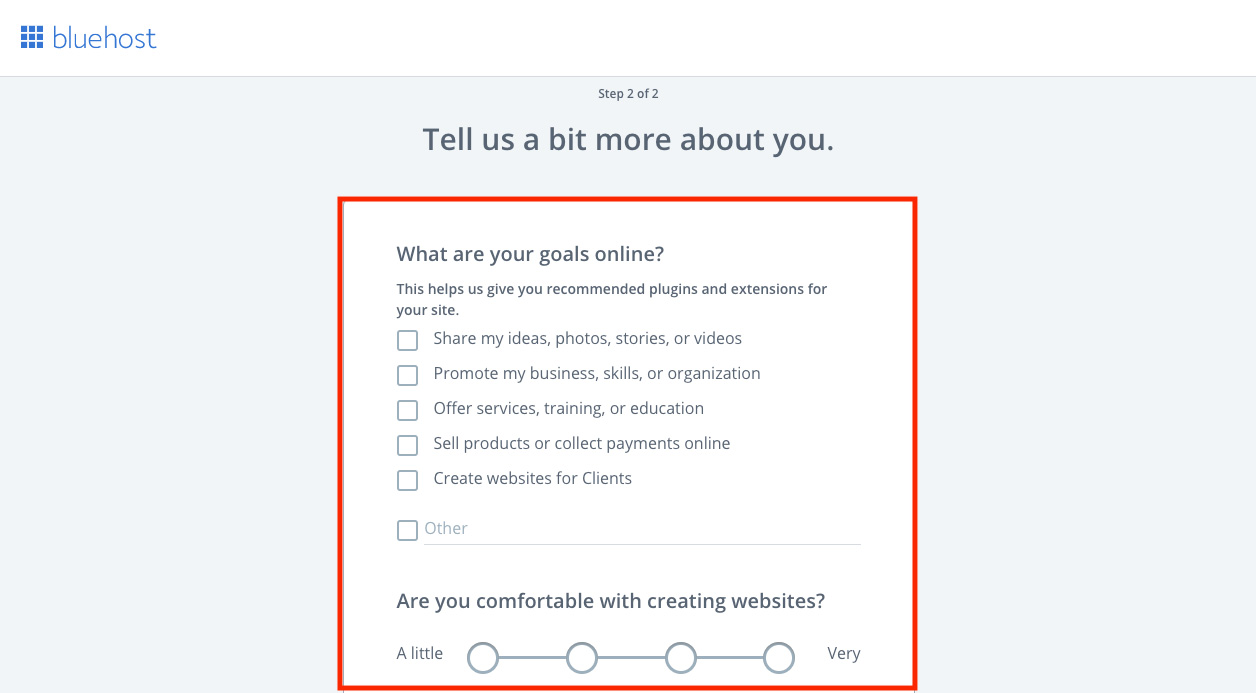
Bluehost
While hosting gives you a space on the web, it doesn’t take you much further than that. But that’s also one of the great benefits of purchasing web hosting for your blog – that web hosting providers give you almost free reign to do whatever you’d like with the space you’re purchasing.
And that’s where content management systems (CMS) come in. A CMS is the application you use to create and organize your content. There are dozens and dozens of different content management systems, and you’ve likely heard of many of them – Joomla, Drupal, Shopify, Squarespace, Wix, as well as others.
But there’s one CMS that stands out above the rest; and if you’re new to blogging, it’s wise to go with the obvious choice here: WordPress. If you’re using Bluehost, WordPress is the default CMS.
Not only is WordPress.org (not to be confused with WordPress.com, which offers free web hosting but with very limited domain and design options) very user-friendly, but it’s also extremely versatile. Users who start on WordPress will be able to continue using the software as they learn the nitty-gritty of blogging and content management.
Next, Bluehost will ask you to pick your blog’s theme.
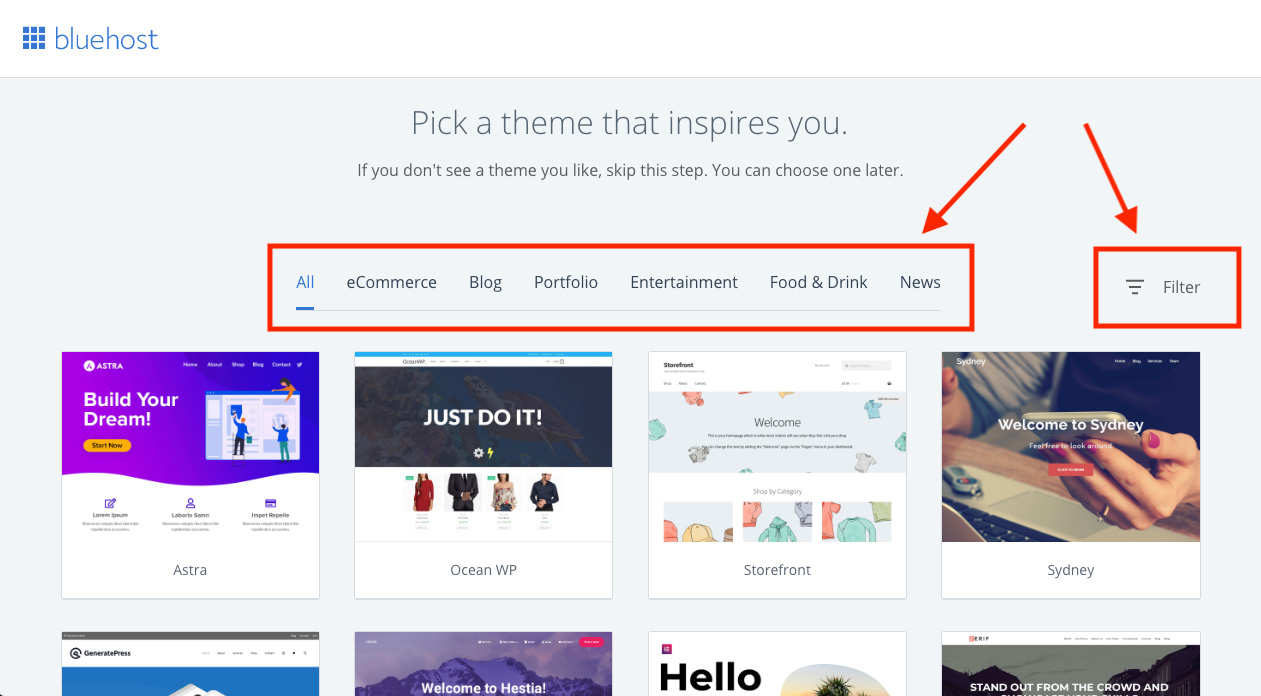
Bluehost
If you’re a first-time blogger, you might be thinking, how should I choose my theme?
There are a few things you’ll want to look for before settling on a theme for your blog:
- Often, developers will limit customization functions for free users, and provide greater customization to premium members. Make sure, whether your theme is free or paid, that you’re going to be able to manipulate it to accomplish your vision.
- How many people are using your theme, and what do the reviews look like? On one hand, you don’t want to pick the theme that everyone’s using; but at the same time, you want to make sure you’re choosing a theme that people trust and have found success using.
- In all likelihood, the theme will look good on a desktop computer. But does it look good on mobile? How about on a tablet? In WordPress’s editor, you’re able to view exactly how things will look on other devices.
- Do the developers provide support to those using their theme? Sometimes developers only make support available to members who have upgraded to the premium versions of their themes.
When setting up your theme for the first time, don’t feel as though you’ve got to nail your choice. You can always change your theme in WordPress later on; choose one you’re content with to start.
Voila! You have the bones of your blog.
After choosing your theme, you’ll be redirected to Bluehost’s portal. But this time, the portal will look a little different.
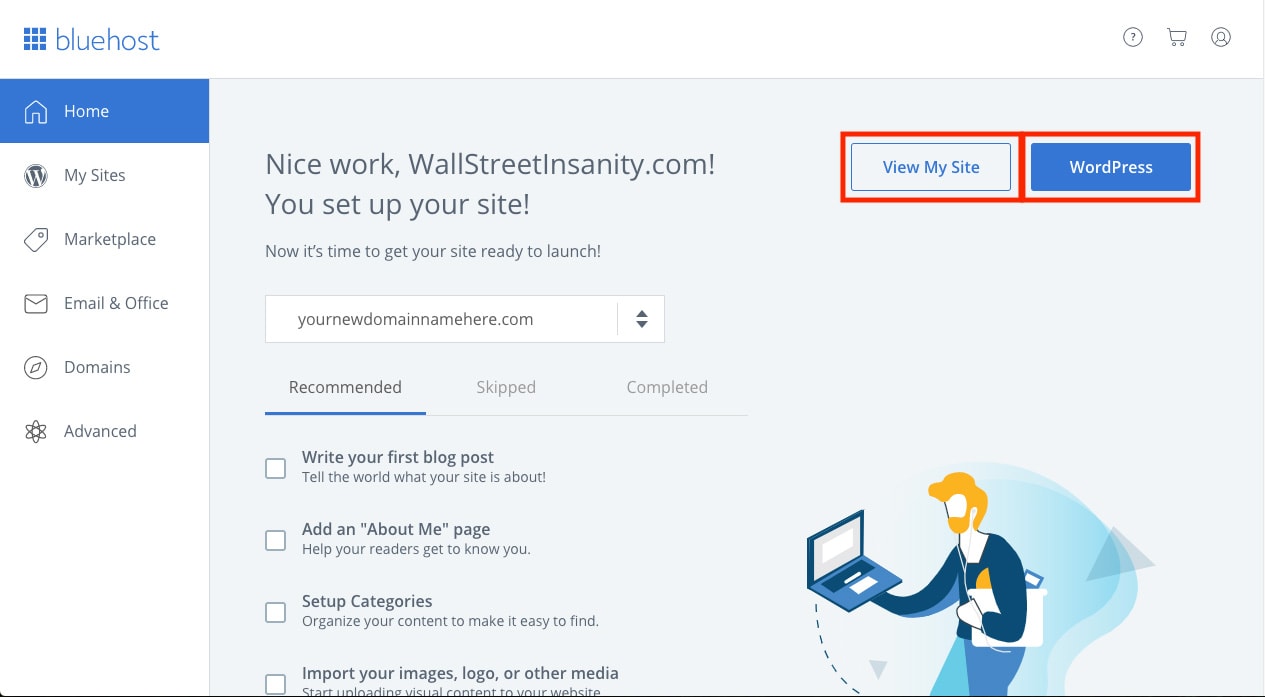
Bluehost
Right away, you’ll notice the “List to Launch”. These are steps Bluehost suggests you take before publishing your blog and making it live. Then, in the upper right corner of your portal page, you’ll see two buttons: “View My Site” and “WordPress”.
Click “View My Site” and you’ll see a message that confirms your blog isn’t live yet.
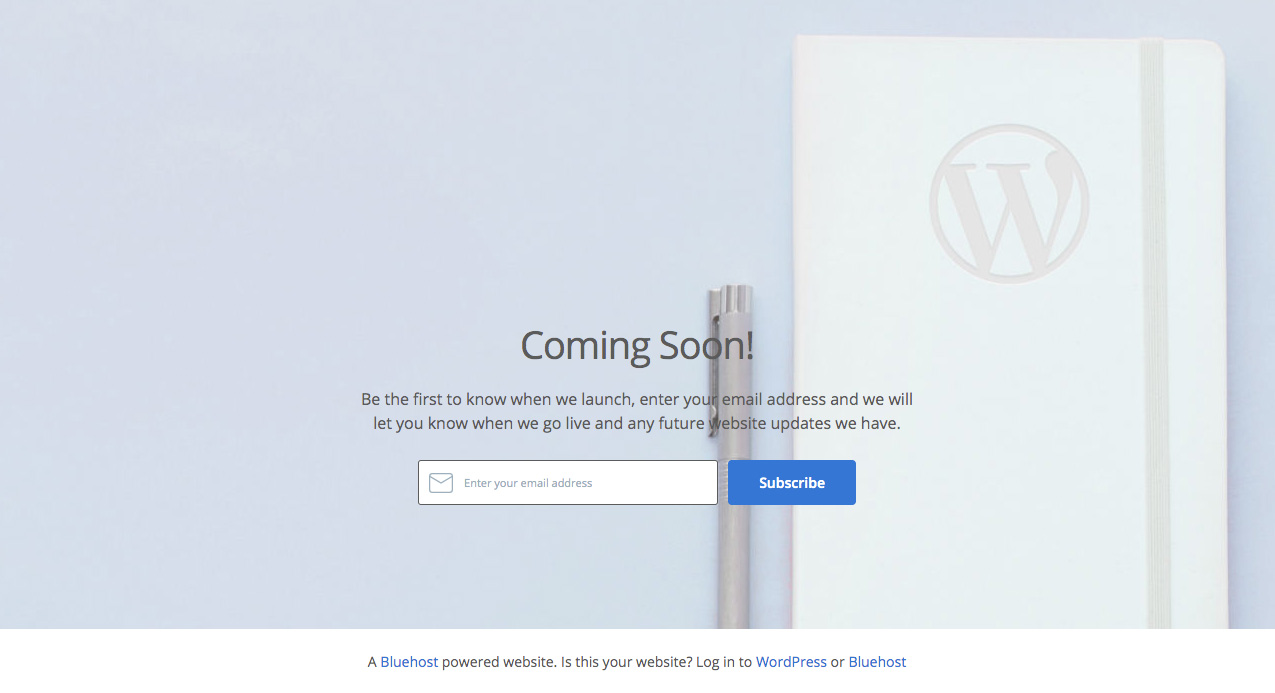
Bluehost
Click the “WordPress” button, on the other hand, and the dashboard for your site will open up. Right now, it should look something like this:
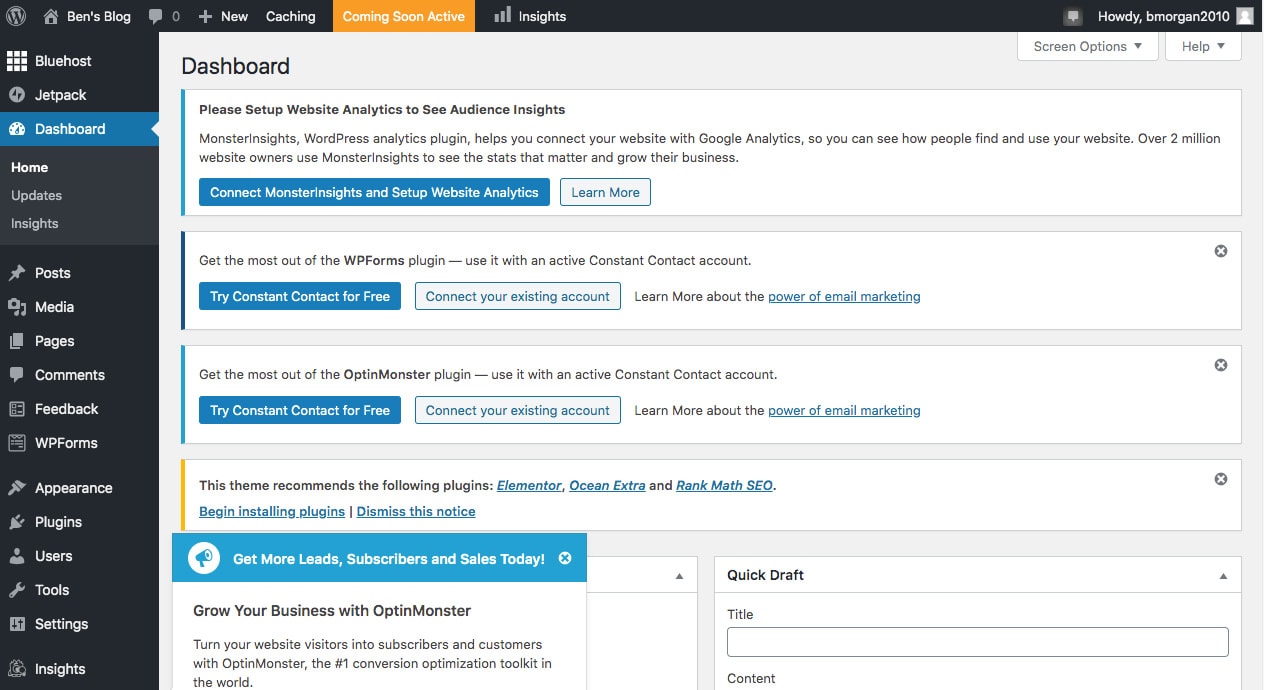
WordPress
On the top toolbar, you’ll see a glowing orange button that reads “Coming Soon Active”. When you’re ready to go live with your blog, click this button and then click “Launch”. You can do this at any time, but you should start filling out some of the content on your site first.
Now is also an ideal time to start installing what we call plugins. In short, these are additional features that you can add on to your theme to make your job as a blogger and site manager easier.
Here are a few of the most popular free plugins that people use within WordPress:
- Yoast SEO. If you don’t download any other plugin, just make sure you add the Yoast SEO plugin to your arsenal. With this little WordPress staple, you’ll be able to fine-tune your search engine optimization efforts on every single page and post, receiving real-time feedback and suggestions about how to improve your content.
- Contact Form 7. Eventually, you’re going to want to use your blog to generate leads – or at the very least, a list of email/newsletter subscribers. With more than 5 million active installations, this plugin allows WordPress users to create and manage all of their opt-in forms with very little coding at all.
- Google Analytics Dashboard for WordPress. Google Analytics is an essential tool that site managers use to track and monitor traffic on their websites and blogs. Eliminating the hassle of jumping between Google Analytics and the WordPress editor, this plugin from ExactMetrics allows the user to keep a small Google Analytics dashboard within their WordPress dashboard.
- Compress JPEG and PNG Images. In creating content for your blog, you should incorporate pictures often to break up your writing. However, working with images can be tricky, as their file sizes are not always optimized for blog posts. While a large file may slow down your website and harm your SEO, a small file may look pixelated. This handy plugin will help you get your images to appropriate sizes for all of your posts.
5. Add Pages and Write Your First Blog Post
Your website is up. But to this point, your theme is probably very plain.
While your theme will have a few pages installed, you may want to add new pages to your site or delete unnecessary pages.
Adding a new page is simple. Navigating your WordPress dashboard, find the Pages tab, and click “Add New”.
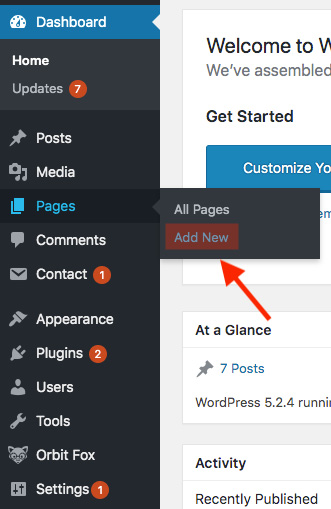
WordPress
Once you have added a few pages that you think your site will need, start filling in general content for the site (main copy for your home page, a bio for your “about me” page, etc.)
Now it’s time to turn your attention towards the blog itself!
Writing and publishing your first blog post requires a series of steps, the first of which is to create the actual content for your blog post.
If you don’t yet have a specific idea for your blog post, spend some time brainstorming different ideas within your niche. You can also try running an online search for topics that you might want to tackle.
Once you have a topic in mind, start writing your blog post! Whether you’re using a Word doc, a Google doc, or the WordPress post editor itself, there are a few things you should keep in mind when creating your content:
- Write to capacity. If you’re writing about a single tip, your blog post may only need to be 300-400 words long. If you’re covering a large topic, your blog posts may need to be upwards of 3,000 words long.
- Search engines like long-form content. There’s nothing wrong with a 300-400 word post, but long-form content does outperform short-form content, historically. According to research from Moz across more than one million articles, long-form content consistently receives more shares and clicks than short-form content.
- Keep your writing simple. With a blog post, you shouldn’t be looking to show off your incredible vocabulary. Instead, you should be aiming to write at around a seventh grade reading level on the Flesch-Kincaid readability scale.
- Break up your writing. When writing, it’s important to find different ways to break up your content. Keep your paragraphs short (no more than three sentences), use plenty of H2 headings and subheadings, and add pictures to break up the text.
- Apply SEO best practices. The more you blog, the more you’ll understand how to make reader-friendly content that search engines also like. To start, use a handful of basic SEO principles to increase search engine visibility. At the very least, you should have a different keyword (relevant to your blog’s niche) for each blog post, and use that keyword in your title, meta description, and the content itself.
6. Polish and Publish Your First Blog Post
Now that you have your first blog post, it’s time to load it into WordPress and get it published!
Visit your WordPress dashboard, and under the Posts tab, click “Add New”.
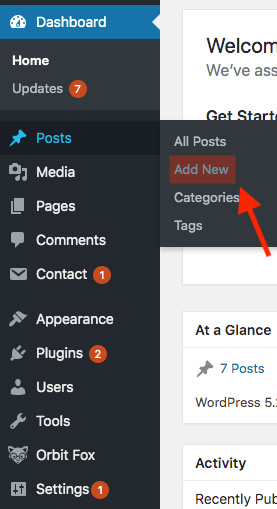
WordPress
Once your post editor loads, copy and paste all of the content from your Word document into WordPress. If you haven’t already marked your headings and subheadings, go ahead and mark them as H2s, H3s, and so on. All of your normal text should be formatted as paragraph.
Next, scroll down to the bottom of your page. If you installed the Yoast SEO plugin earlier, you should see a plugin with SEO, readability, and social tabs. At the very least, you should be using the Yoast plugin to refine SEO within your blog post.
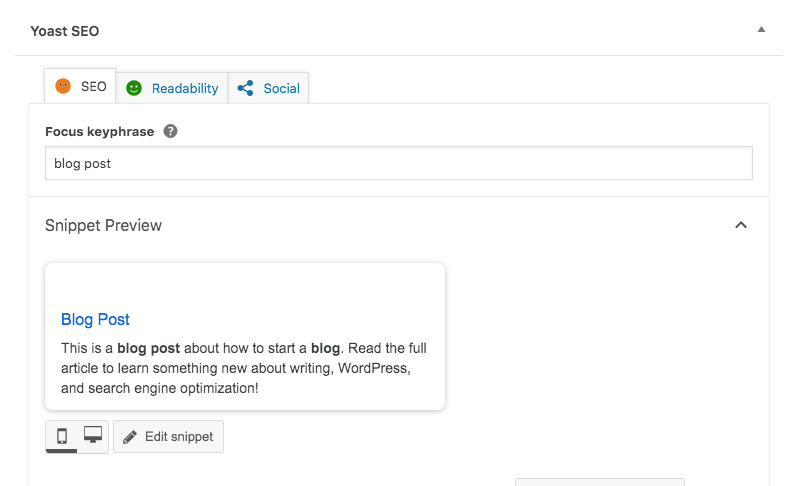
Yoast
Load in your focus keyword or keyphrase for the piece. The Yoast plugin will immediately adjust, and point out all of the different areas where your SEO is good, bad, or in need of improvement.
Scroll down the analysis results section of the plugin. As you can see in the example below, there are areas where our sample blog post’s SEO is good! But there are also a few areas we need to clean up. Work through these issues until you achieve a good overall SEO score.
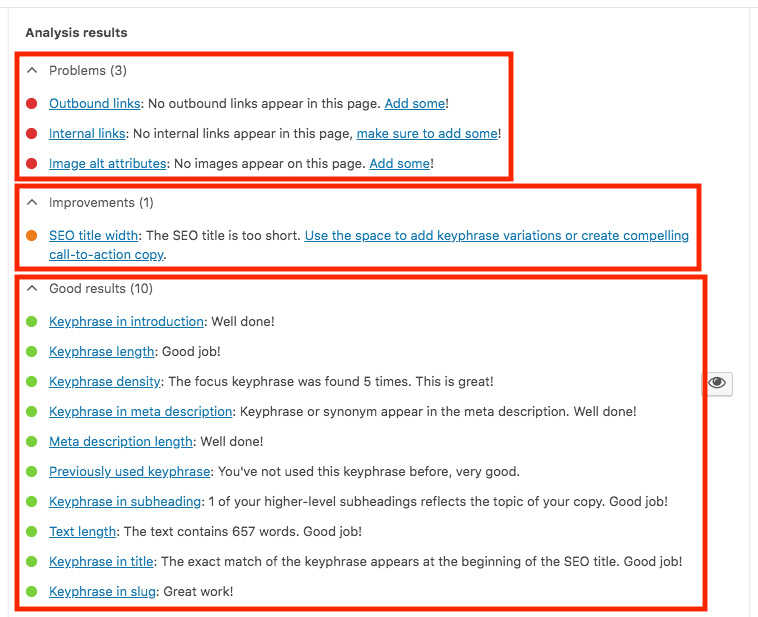
Yoast
Keep in mind that the Yoast SEO plugin is only a tool to help gauge whether or not your post will perform well in search engines. Only Google (or Bing, Yahoo, etc.) knows the exact algorithm that determines how well a post performs within the engine’s search results.
Generally speaking, Google wants to see content that is helpful to readers. So, when in doubt, make sure you’re writing content for readers. Checking off every last to-do item within your Yoast SEO plugin might make disrupt the flow of your writing, making it clunky and less reader-friendly.
The Yoast SEO plugin is a great guide, but don’t treat it as gospel.
Once you’re happy with your blog post’s SEO score and the way it looks within the editor, you’re ready to schedule it to be published!
In the right-hand column of your editor, you’ll see a handful of toolbars – most importantly, “Status & Visibility”, “Categories”, and “Featured Image”:
- Status & Visibility. Here, you’ll need to set the parameters for your blog post’s visibility. Under most circumstances, you will want your post to be “public” and you’ll want it to be published immediately. But once you get a few blog posts under your belt, you might choose to get ahead and schedule your posts to be published at a certain time and day of the week.
Assuming you don’t plan for your first blog post to also be your last, you’re going to need a way of organizing your blog content – not only for you but also for future readers. Create a few subtopics you think you might need, and select the one(s) that are most applicable to your first post.
- Featured Image. Every great blog post has a great header image to go with it. However, you need to be careful about what images you use, as you can quickly get in trouble if you’re not the owner of your image. Fortunately, there are a few different sources where you can get stock images for your blog posts. A few of the best include Unsplash, StockSnap, and Pixabay. Just double check each time that the image you’re downloading is free to use.
Now, the moment you’ve been waiting for … hit “publish” to make your first blog post live!
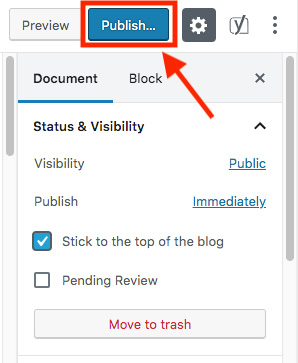
WordPress
7. Market Your Blog and Build an Audience
Soon after you’ve published your first blog post, you’ll find out that readers don’t magically appear on your blog …
Without marketing your content, it will take you a while to see any traffic at all!
There are plenty of ways to market your content and start building an audience. Some are free, while others are paid. Let’s highlight a few of the most popular methods.
Social Media
When you’re looking to spread the word about your blog quickly and cheaply (in this case, free!), social media is the first place you should go.
If you don’t already have active social media accounts – particularly on some of the larger platforms, such as Facebook, Instagram, Twitter, and LinkedIn – spend some time creating complete profiles for each.
Once you have a few active social media accounts, you have everything you need to start building your audience! Here are a few tips to help you get people to your blog:
- Follow people within your industry/niche (they might follow back!)
- Like, share, and leave comments on their content
- Start curating and posting content to your pages (a good rule of thumb is to post 80% content from other people, and 20% of your own)
With time, as you interact with other people and form relationships, you’ll start getting some blog traffic from social media.
Pair this with regular blogging, and it should only be a matter of time before you start drawing traffic from both organic search results and social media marketing efforts.
Paid Social Media Ads
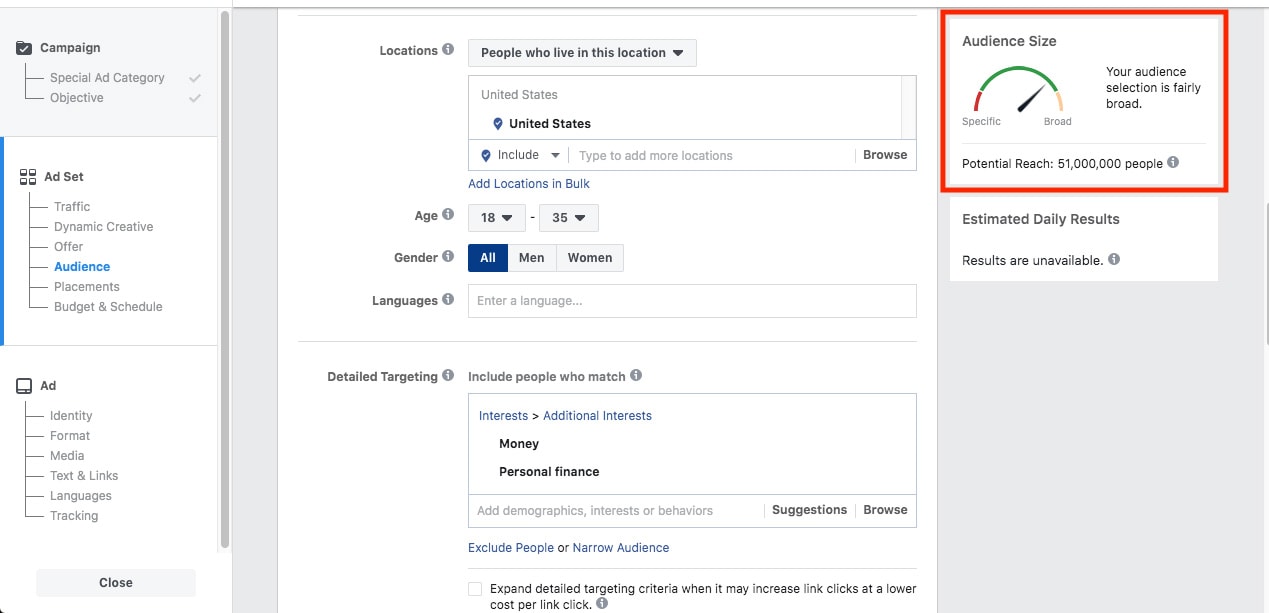
Additionally, you can choose to run paid ads via social media.
With a large platform like Facebook, the ad customization options are nearly endless. You’ll be able to set a fixed budget for your campaign and target only those who fall within the parameters you set, so that your ad reaches only the most relevant readers.
If your niche is rock climbing, for example, you might choose to target men and women between the ages of 18 – 40, whose interests include “rock climbing”, “outdoors”, “nature”, and “extreme sports”. These few changes alone will allow you to take an otherwise broad audience and makes it more specific.
Guest Posting
Another way to get the word out about your blog is to start guest posting and interviewing for other names within your niche. This allows you to access another segment of your target audience; but with guest posting or interviewing, you’re also getting the endorsement of someone whom these followers trust.
The best way to earn a guest posting or interviewing opportunity is to approach it relationally. Cold emailing people and asking them to let you guest post typically doesn’t yield great results. Instead, starting forming relationships over social media. Find someone you respect within your industry and add him or her on LinkedIn. Join a few Facebook groups and start interacting with people.
Over the next two or three months, like and share content from a few people, and try to show them that you’re genuinely interested in what they do (without coming off as obsessive or overbearing).
Once the time is right, send them a private message to officially introduce yourself. There’s a right way to do this and a wrong way to do this. Here are a few of the dos and don’ts:
DO:
- Personalize your direct message for the person you’re contacting
- Talk about the person’s content and an area where you can share your expertise/experience
- Focus on the value you can provide that person’s audience
- Be casual/conversational
DON’T:
- Use a copy/paste, generic template for all of your direct messages
- Make the message all about you
- Be on a mission to prove that you’re exactly what the person needs
- Be rigid/uptight
As long as you’ve taken the time to develop meaningful connections, your private messages should, at the very least, be welcomed and respected. While you may get “no thanks!” a few times, you’ll likely get at least one “yes”; and that one opportunity might be worth it all!
Google Ads
If you have a budget, you might consider using Google Ads to generate traffic for your blog.
While using Google Ads has the potential to be an expensive endeavor, it doesn’t have to be. You’re in complete control of your advertising costs at all times. Simply set a monthly cap for what you’re willing to spend.
Here’s the best part about running ads online: you pay for clicks.
If you purchase an ad in the newspaper, you’re paying a fee without any guarantee that a) people will even see your ad, or b) people will pick up the phone and give you a call.
With Google Ads, you pay only for the people who see your ad and click through to your blog.
8. Monetize Your Blog
The reality is that monetization options are going to be slim until you’ve built up a sizable audience of monthly readers. But once you see that your blog is getting at least a few thousand readers per month, you’re in territory where you can start making money.
Let’s look at a few of the different ways in which you can earn income through a successful blog.
Affiliate marketing
As an affiliate, you use your content and marketing efforts to send visitors and customers to partners’ sites.
Here’s the “short version” of how the process works:
- Step #1: Join an affiliate program and receive the link(s) that the partner wants you to use.
- Step #2: Promote the product or service within your blog content, including the link for your readers to click.
- Step #3: When a reader uses your link to make a purchase from your partner, you earn a commission for that sale. The value of your earnings is typically dependent on a few factors, including the agreed rate and the amount of the customer’s purchase.
As you can imagine, a large following on your blog makes affiliate marketing that much easier. Many bloggers are able to make a full-time income from affiliate marketing alone!
Advertising
Once your blog is seeing significant traffic each month, there’s a good chance that you’ll start drawing interest from companies that are interested in using your site (and audience) for their own ads.
Many bloggers elect not to rent out advertising space on their sites, for fear of their blogs looking gimmicky or cluttered. But renting out ad space to just a few businesses can limit this.
As long as you own your blog, you have relative freedom to set the terms for your advertising space. You might offer any of the following ad types:
- Pay per click ads (PPC)
- Cost per impression (mille) (CPM)
- Pop-up ads
- Paid reviews
Selling products and services
Especially once you’ve established yourself as an authoritative voice within your niche or industry, you can start selling products and services online. Because you’re already providing valuable blog content to your readers for free, they are more likely to trust you and see the value in making a purchase.
There are plenty of products and services you might choose to sell on your website or blog. Here are a few ideas:
- eBooks
- Access to premium content
- Courses
- Webinars
- Merchandise
- Private coaching
- Blogging services
- Other services related to your specific niche
While it may take costs some money to develop these resources, a large audience presents a huge opportunity to not only recoup those costs but also earn a profit!
Ready to Start Your Blog?
Now that you know how to start a blog with Bluehost, how about building a successful blog of your own?
While setting up a blog might be relatively easy, the road to generating traffic and monetizing your blog can prove to be challenging. But stick with it! Blogging is about producing quality consistently.
Whether you’re after a proven side hustle that can earn you a little extra dough, or whether you’re looking to replace your current income and enjoy the remote







































